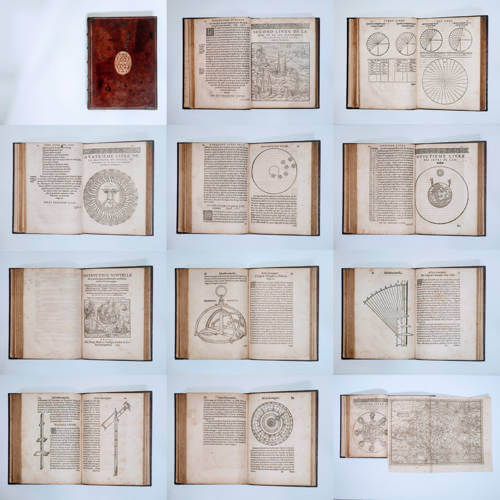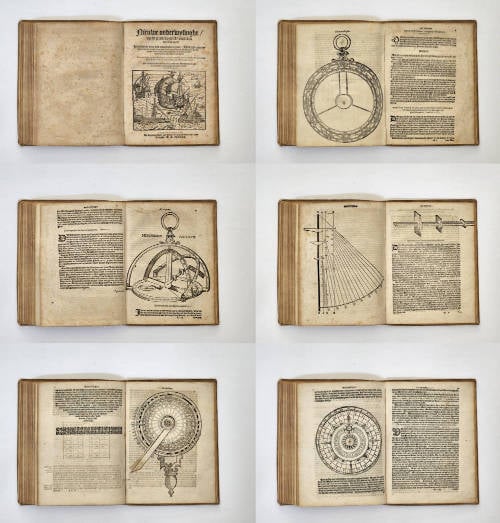Leen Helmink Antique Maps
Old books, maps and prints by Michiel Coignet
Michiel Coignet (1549-1623)
Michiel Coignet: A Flemish Polymath of the Late 16th Century
Early Life and Education
Michiel Coignet, born in 1549 in Antwerp, was a figure of considerable influence in the late 16th and early 17th centuries. He was the son of Gillis Coignet, a renowned goldsmith and maker of astronomical and mathematical instruments. This familial background provided Michiel with an early exposure to both the practical and theoretical aspects of science and engineering. His mother, Brigitte Anthonis Hendriks, ensured the continuation of the family's workshop after Gillis's death in 1562 or 1563 when Michiel was just thirteen.
Coignet's education remains somewhat speculative, but it is believed he was trained in mathematics by Valentin Mennher, a respected teacher in Antwerp known for his advanced knowledge in algebra and trigonometry. By 1568, at the age of nineteen, Michiel was already established as a schoolmaster under the patronage of the Guild of Saint-Ambroise, where he taught French and mathematics.
Professional Beginnings
Around 1570, Michiel married Maria vanden Eynde, with whom he would have ten children. This period also marked the beginning of his multifaceted career. He was appointed as a 'wijnroeier' or wine gauger by the city of Antwerp in 1572-73, a position that required precise mathematical skills for measuring wine for tax purposes. His first known signed instrument, an astrolabe, dates from this year, highlighting his early involvement in instrument making.
Coignet's career took a significant turn when he converted to Protestantism, but after the Fall of Antwerp in 1585, he seemingly reconverted to Catholicism to join the 'kolveniersgilde', a local militia where only Catholics were allowed. This period of his life was marked by a shift from teaching general classes to focusing on educating military officers and the sons of wealthy merchants.
Contributions to Navigation and Instrument Making
In 1580, Coignet published "Nieuwe Onderwijsinghe op de principaelste Puncten der Zeevaert" (New Instructions on the Principal Points of Navigation), which was appended to the Dutch translation of Pedro de Medina's "Arte de Navegar." This work was pivotal, introducing new navigational instruments and techniques, including the nautical hemisphere, aimed at solving the longitude problem at sea. His treatise was not only scientific but also practical, making it a staple on Dutch ships exploring new routes around the globe.
Scientific Instruments and Correspondence
Coignet was also a prolific inventor and manufacturer of scientific instruments. He corresponded with many of the era's leading scholars, including Galileo Galilei, with whom he exchanged ideas from 1588, and other luminaries like Gerhard Mercator and Ludolph van Ceulen. His workshop in Antwerp became known for producing astrolabes, sundials, armillary spheres, and various surveying instruments, often incorporating innovations that would later be seen in more famous devices like the proportional compass.
Service to the Archdukes
From 1596, Coignet entered the service of the Archdukes Albert VII and Isabella Clara Eugenia, the governors of the Spanish Netherlands, where he held a position akin to that of Simon Stevin at the court of Maurice of Nassau. Here, he served as a mathematician, engineer, and cosmographer, receiving a stipend in 1604 for his work in cosmography. His role involved not only the creation of maps and navigational aids but also military engineering, contributing to fortifications along the Scheldt River.
Later Life and Legacy
After the death of his first wife in 1605, Coignet remarried Magdalena Marinus in 1606, having four more children. His second son from this marriage, Michiel II Coignet, would also make a name for himself as a painter. Despite his extensive contributions, Coignet's works were not published posthumously as planned after his death on December 24, 1623. His legacy, however, persisted through his instruments and his navigational guide, which was carried on numerous Dutch expeditions, influencing navigation in the Age of Exploration.
Conclusion
Michiel Coignet's life encapsulates the spirit of the Renaissance polymath, contributing to a range of disciplines from mathematics and navigation to instrument making and military engineering. His work, while perhaps less celebrated than some contemporaries, was foundational in advancing the scientific understanding and practical application of navigation during a period of intense maritime exploration. His influence can still be traced in the history of scientific instruments and the navigational practices that helped shape global exploration.

